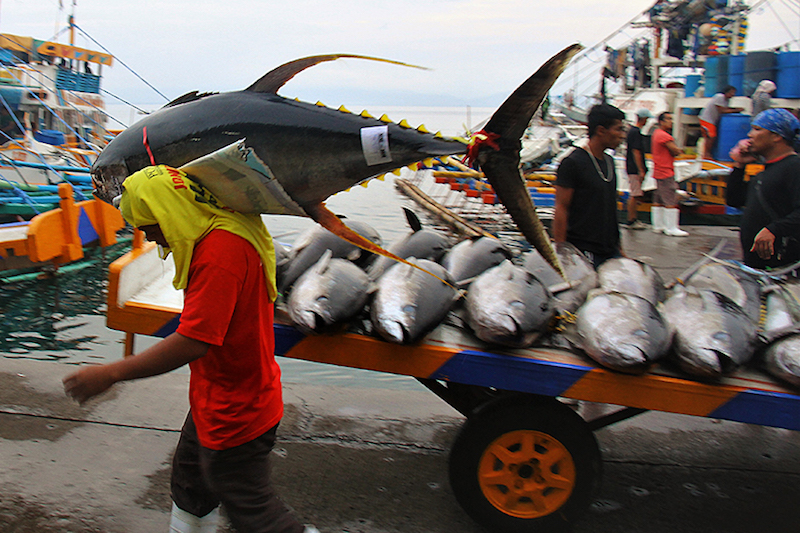GENERAL SANTOS CITY (MindaNews/05 September) – Agriculture Secretary William Dar urged tuna industry players to continually upgrade their operations, especially their fishing fleets, to make them more competitive in the expanding global markets.
Speaking at the opening of the 2019 National Tuna Congress here on Thursday, Dar said it is important for the industry to modernize all aspects of its systems and processes so it can catch up with other top tuna-producing countries.
 A laborer unloads a tuna from a fishing vessel, on Saturday, August 26, 2018, at the usual Market Shed 1 of the General Santos City Fish Port Complex. Fish traders at the port noted a decline in the supply of smaller fishes after a fishing ban on known fishing pockets in international seas took effect. Photo by ROMMEL G. REBOLLIDO
A laborer unloads a tuna from a fishing vessel, on Saturday, August 26, 2018, at the usual Market Shed 1 of the General Santos City Fish Port Complex. Fish traders at the port noted a decline in the supply of smaller fishes after a fishing ban on known fishing pockets in international seas took effect. Photo by ROMMEL G. REBOLLIDO
He specifically cited the need for fishing companies to acquire more modern fishing fleets than can better navigate through the high seas to further increase their productivity levels.
Dar cited that the existing tuna fishing fleets in the country are quite limited and the technologies used in most of the vessels are below the standards of those from other countries.
He said such problem was among the reasons why foreign fishing vessels mainly control the tuna fishing grounds in the high seas, including those situated in the country’s territorial waters.
Industry records showed that a total of 1,957 fishing vessels are currently being operated by around 270 registered fishing operators based in the city.
Of these, only 141 are large purseine vessels that operate in the high seas, especially in the tuna fishing grounds in the Pacific.
“One way to better compete (in the high seas) is to modernize our fleets. Re-fleeting is the way forward,” Dar said.
He said there are available technologies and innovations that the industry may adopt, among them equipping the vessels with postharvest and processing facilities.
These will enable companies “to do some value-adding in the high seas and gain much better income at the end of the day.”
Dar said the Department of Agriculture and the Bureau of Fisheries and Aquatic Resources will work with banking institutions for access to the needed funding.
“We will see to it that lending windows for re-fleeting will be there to support the tuna industry,” he said.
He said they will also support these initiatives through research and development programs that will help upgrade fishing operations and the processing aspect.
Dar challenged the industry, which he valued at around P240 billion, to be more inclusive with their operations to ensure that the small fisher folk will also benefit from its gains.
He said the “big brothers” of the industry should not forget the other layers of the sector, especially the “down-trodden” fishermen in the coastal communities.
“You must see to it that you bring with you in prosperity the smaller stakeholders of the industry,” he said.
Dubbed the “Tuna Capital of the Philippines,” the city hosts six of the country’s eight tuna canneries.
The industry, which generated export receipts of around P22 billion in 2018, directly employs some 27,290 people and provides livelihood to 109,160 others through various secondary activities. (MindaNews)
